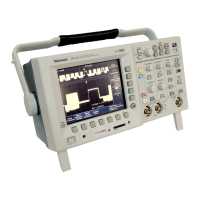Utility
3–66
TDS3000 Series User Manual
Key Points
RS-232 Troubleshooting. If you are having difficulties with RS-232
communication, try the following remedies:
Verify that you are using the correct RS-232 cable and adapters.
Most computers require a null-modem connection to the
oscilloscope. Most printers require a straight-through connection
to the oscilloscope.
Verify that the RS-232 cable is connected to the correct port on
your computer or hard copy device.
Reset the RS-232 parameters to defaults and then set the baud
rate to match the computer or hard copy device. The default
settings (except baud rate) are standard on most computers and
hard copy devices.
Enable the debug window to see the RS-232 status, errors, data
transmitted, and data received.
Refer to the TDS3000-Series Programmer Manual for more
information about using the RS-232 port.
GPIB Guidelines. Follow these guidelines when you connect your
oscilloscope to a GPIB network:
Turn off the oscilloscope and all external devices before
connecting the oscilloscope to the GPIB network.
Assign a unique device address to the oscilloscope. Two devices
cannot share the same device address.
Turn on at least two-thirds of the GPIB devices while using the
network.
Refer to the TDS3000-Series Programmer Manual for more
information about using the GPIB port.
Ethernet Guidelines. Refer to the TDS3000-Series Programmer
Manual for Ethernet setup and troubleshooting guidelines.
